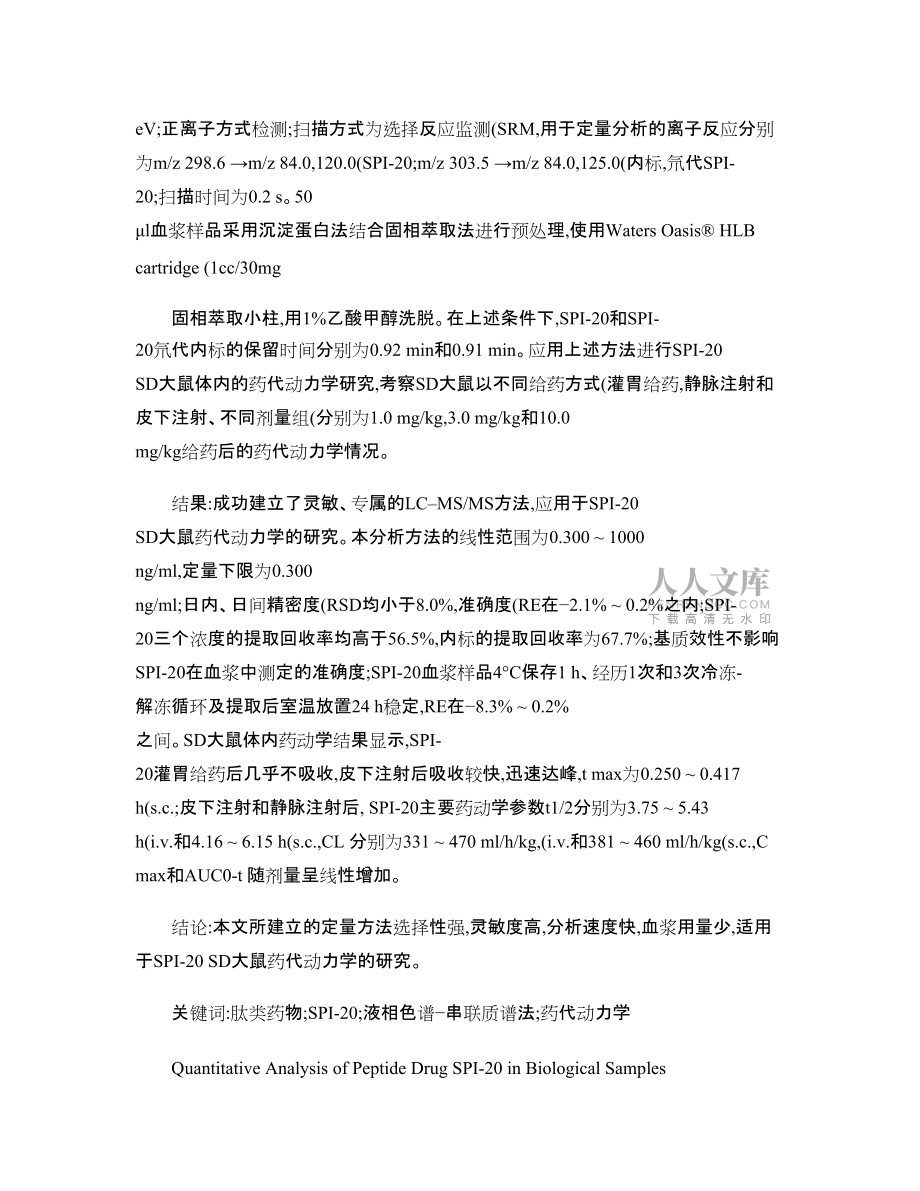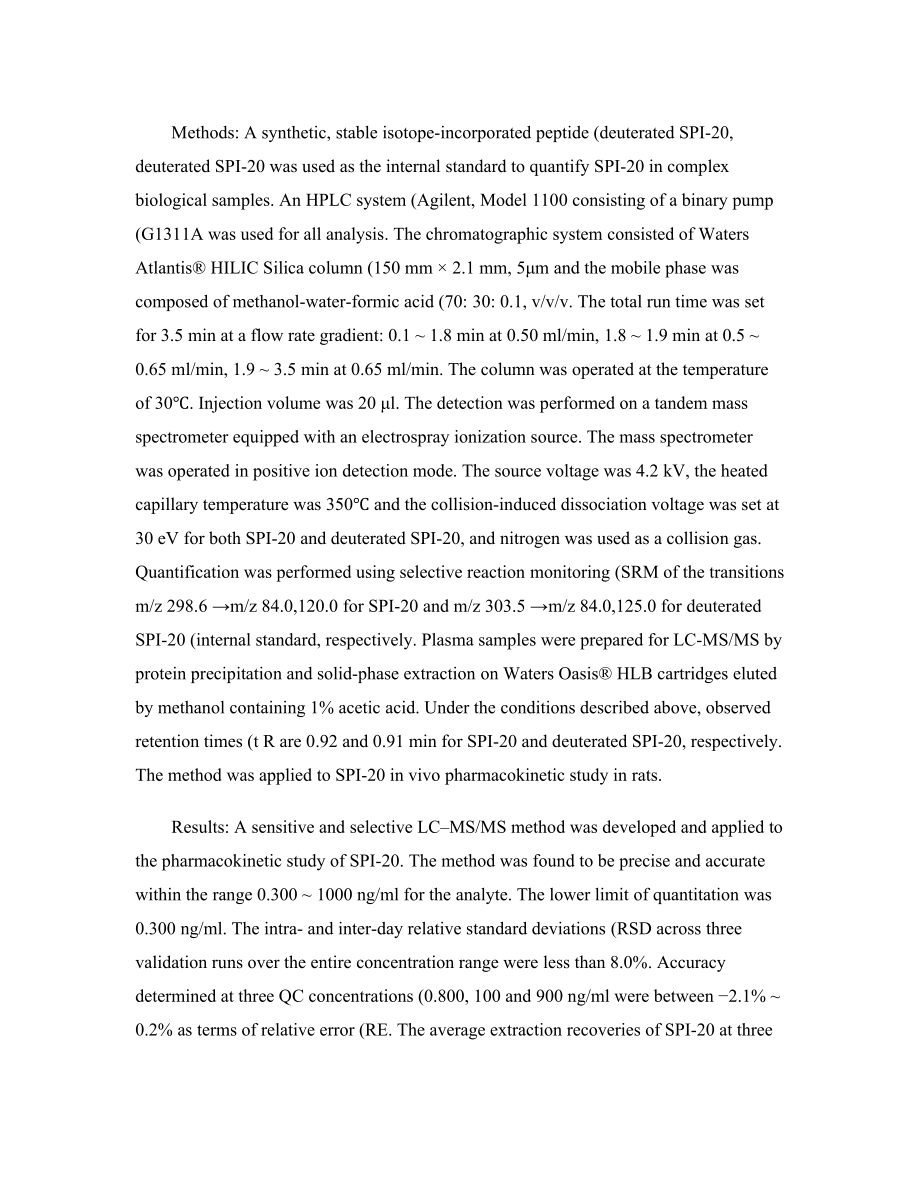




下载本文档
版权说明:本文档由用户提供并上传,收益归属内容提供方,若内容存在侵权,请进行举报或认领
文档简介
1、生物样品中肽类药物SPI-20定量分析方法研究药学院 3041909032 谢岑药物制剂0401指导老师钟大放研究员上海药物研究所陈笑艳研究员上海药物研究所摘要背景:SPI-20为全合成的阿片类受体激动剂的候选药物,是皮啡肽的衍生物。它对于受体具有高选择性,镇痛作用显著且副作用小,可能成为新一代镇痛药。SPI-20为四个氨基酸组成的肽类药物,相对分子质量为595.7,具有极性大、不易透过生物膜、易酶解等特点。液相色谱-质谱联用法将色谱的高分离性能和质谱的高鉴别特点相结合,组成了较完美的现代分析技术,近年来已被广泛用于药代动力学研究。本课题以SPI-20为模型药物,拟建立SPI-20的LC-MS
2、/MS 生物分析方法,研究此类候选药物在SD大鼠体内药动学特征。目的:建立灵敏、快速的液相色谱-串联质谱法测定生物样品中的SPI-20,并应用于SPI-20 SD大鼠药代动力学的研究,为新型肽类阿片受体激动剂的开发提供依据。方法:使用同位素标记物氘代SPI-20作为定量分析时的内标。色谱条件为:分析柱采用Waters Atlantis® HILIC Silica色谱柱(150 mm × 2.1mm, 5m;流动相为甲醇:水:甲酸(70: 30: 0.1, v/v/v;采用流速梯度洗脱:0.1 1.8 min,流速为0.50 ml/min;1.8 1.9 min,流速为0.5
3、 0.65 ml/min;1.9 3.5 min,流速为0.65 ml/min;柱温30;进样量20 l。质谱条件为:离子源为电喷雾电离源(ESI 源;离子源喷雾电压为4.2 kV;加热毛细管温度为350;鞘气(N2压力35 Arb;辅助气(N2压力5 Arb;碰撞气(Ar压力2 mTorr;碰撞诱导解离(CID电压均为30 eV;正离子方式检测;扫描方式为选择反应监测(SRM,用于定量分析的离子反应分别为m/z 298.6 m/z 84.0,120.0(SPI-20;m/z 303.5 m/z 84.0,125.0(内标,氘代SPI-20;扫描时间为0.2 s。50 l血浆样品采用沉淀蛋白法
4、结合固相萃取法进行预处理,使用Waters Oasis® HLB cartridge (1cc/30mg固相萃取小柱,用1%乙酸甲醇洗脱。在上述条件下,SPI-20和SPI-20氘代内标的保留时间分别为0.92 min和0.91 min。应用上述方法进行SPI-20 SD大鼠体内的药代动力学研究,考察SD大鼠以不同给药方式(灌胃给药,静脉注射和皮下注射、不同剂量组(分别为1.0 mg/kg,3.0 mg/kg和10.0 mg/kg给药后的药代动力学情况。结果:成功建立了灵敏、专属的LCMS/MS方法,应用于SPI-20 SD大鼠药代动力学的研究。本分析方法的线性范围为0.300 10
5、00 ng/ml,定量下限为0.300 ng/ml;日内、日间精密度(RSD均小于8.0%,准确度(RE在2.1% 0.2%之内;SPI-20三个浓度的提取回收率均高于56.5%,内标的提取回收率为67.7%;基质效性不影响SPI-20在血浆中测定的准确度;SPI-20血浆样品4°C保存1 h、经历1次和3次冷冻-解冻循环及提取后室温放置24 h稳定,RE在8.3% 0.2% 之间。SD大鼠体内药动学结果显示,SPI-20灌胃给药后几乎不吸收,皮下注射后吸收较快,迅速达峰,t max为0.250 0.417 h(s.c.;皮下注射和静脉注射后, SPI-20主要药动学参数t1/2分别
6、为3.75 5.43 h(i.v.和4.16 6.15 h(s.c.,CL 分别为331 470 ml/h/kg,(i.v.和381 460 ml/h/kg(s.c.,C max和AUC0-t 随剂量呈线性增加。结论:本文所建立的定量方法选择性强,灵敏度高,分析速度快,血浆用量少,适用于SPI-20 SD大鼠药代动力学的研究。关键词:肽类药物;SPI-20;液相色谱串联质谱法;药代动力学Quantitative Analysis of Peptide Drug SPI-20 in Biological Samplesand Its ApplicationsCollege of Pharmace
7、utical Sciences 3041909032 XIE CenPharmaceutics 0401Advisors Prof. ZHONG Dafang Shanghai Institute of Materia MedicaProf. CHEN Xiaoyan Shanghai Institute of Materia MedicaAbstractThe synthetic peptide SPI-20 is a highly potent and selective mu opioid-receptor agonist, which has been based on modific
8、ation of the dermorphin sequence. It has potential as an analgesic drug that is relatively free of side effects because of those physicochemical properties. It is composed of four peptides and its molecular weight of 595.7 Da. Also, it is a very polar molecule that is unlikely to cross biological me
9、mbrane. Liquid chromatography-mass spectrometry have been widely used for the quantitative analysis of trace levels of pharmaceutical drugs, metabolites and peptides, which combines high separation of chromatography with strong identification of mass spectrometry. On the basis of comprehensive pract
10、ical experience in the analysis of small molecules, pharmaceutical research is developing technologies for analysis of a growing number of peptide drug candidates. The aim of this study was to develop and optimize a liquid chromatography-tandem mass spectrometric method for the determination of SPI-
11、20 in complex biological matrix and to study the non-clinical pharmacokinetics of SPI-20 in rats.Objective: To develop sensitive and specific liquid chromatography-tandem mass spectrometric method for determination of SPI-20 in complex biological matrix and to study the non-clinical pharmacokinetics
12、 of SPI-20 in rats. The data will support the clinical development for further peptide opioid-receptor agonist candidates.Methods: A synthetic, stable isotope-incorporated peptide (deuterated SPI-20, deuterated SPI-20 was used as the internal standard to quantify SPI-20 in complex biological samples
13、. An HPLC system (Agilent, Model 1100 consisting of a binary pump (G1311A was used for all analysis. The chromatographic system consisted of Waters Atlantis® HILIC Silica column (150 mm × 2.1 mm, 5m and the mobile phase was composed of methanol-water-formic acid (70: 30: 0.1, v/v/v. The to
14、tal run time was set for 3.5 min at a flow rate gradient: 0.1 1.8 min at 0.50 ml/min, 1.8 1.9 min at 0.5 0.65 ml/min, 1.9 3.5 min at 0.65 ml/min. The column was operated at the temperature of 30. Injection volume was 20 l. The detection was performed on a tandem mass spectrometer equipped with an el
15、ectrospray ionization source. The mass spectrometer was operated in positive ion detection mode. The source voltage was 4.2 kV, the heated capillary temperature was 350 and the collision-induced dissociation voltage was set at 30 eV for both SPI-20 and deuterated SPI-20, and nitrogen was used as a c
16、ollision gas. Quantification was performed using selective reaction monitoring (SRM of the transitions m/z 298.6 m/z 84.0,120.0 for SPI-20 and m/z 303.5 m/z 84.0,125.0 for deuterated SPI-20 (internal standard, respectively. Plasma samples were prepared for LC-MS/MS by protein precipitation and solid
17、-phase extraction on Waters Oasis® HLB cartridges eluted by methanol containing 1% acetic acid. Under the conditions described above, observed retention times (t R are 0.92 and 0.91 min for SPI-20 and deuterated SPI-20, respectively. The method was applied to SPI-20 in vivo pharmacokinetic stud
18、y in rats.Results: A sensitive and selective LCMS/MS method was developed and applied to the pharmacokinetic study of SPI-20. The method was found to be precise and accurate within the range 0.300 1000 ng/ml for the analyte. The lower limit of quantitation was 0.300 ng/ml. The intra- and inter-day r
19、elative standard deviations (RSD across three validation runs over the entire concentration range were less than 8.0%. Accuracy determined at three QC concentrations (0.800, 100 and 900 ng/ml were between 2.1% 0.2% as terms of relative error (RE. The average extraction recoveries of SPI-20 at three
20、concentrations (0.800, 100 and 900 ng/ml were more than 56.5% and deuterated SPI-20 was 67.7%, respectively. The matrix effect had noimpact on the accuracy. The stability of SPI-20 in plasma at three concentrations (0.800, 100 and 900 ng/ml were found to be stable in plasma after 1 h storage at 4(RE
21、 < 7.1% and after three freezethaw (20 °C/room temperature cycles (RE < 3.1%. The analyte was also shown to be stable after 24 h storage in reconstitution solutions at room temperature (RE < ±8.3%. In the pharmacokinetic study in rat, we found there was no significant absorption after a single oral administration. Maximal SPI-20 plasma level was observed in rat plasma around 0.250 0.417 h after a single subcutaneous injection at three dose
温馨提示
- 1. 本站所有资源如无特殊说明,都需要本地电脑安装OFFICE2007和PDF阅读器。图纸软件为CAD,CAXA,PROE,UG,SolidWorks等.压缩文件请下载最新的WinRAR软件解压。
- 2. 本站的文档不包含任何第三方提供的附件图纸等,如果需要附件,请联系上传者。文件的所有权益归上传用户所有。
- 3. 本站RAR压缩包中若带图纸,网页内容里面会有图纸预览,若没有图纸预览就没有图纸。
- 4. 未经权益所有人同意不得将文件中的内容挪作商业或盈利用途。
- 5. 人人文库网仅提供信息存储空间,仅对用户上传内容的表现方式做保护处理,对用户上传分享的文档内容本身不做任何修改或编辑,并不能对任何下载内容负责。
- 6. 下载文件中如有侵权或不适当内容,请与我们联系,我们立即纠正。
- 7. 本站不保证下载资源的准确性、安全性和完整性, 同时也不承担用户因使用这些下载资源对自己和他人造成任何形式的伤害或损失。
最新文档
- 2025年高精度数字电流表项目合作计划书
- 2025年医用放射治疗设备合作协议书
- 教育建筑环境教育与生态保护的协调发展
- 2025年黑白系列偏光片项目建议书
- 教育技术工具如何改变传统教学模式
- 教育与商业共融的园区物业服务模式
- 医疗心理服务为患者带来心灵的光明
- 教育游戏化的实践与创新策略分享
- 专题04 推-荐信 感谢信 倡议书(讲义)(原卷版)-2025年高考英语二轮复习
- 2025年商丘名校高二物理第二学期期末检测试题含解析
- 医疗机构中药饮片采购流程优化
- 中远海运招聘笔试题库2025
- Session4饥饿与创伤的代谢反应:营养需求课件
- vmc五轴系列产品介绍及技术协议0656evmc0656e-itnc把刀库v1
- 电子产品报价单通用模板
- 礼来公司销售讲座
- 甲苯甲醇烷基化法年产30万吨对二甲苯车间设计分析
- SHR-500A高速混合机
- 挤密夯实水泥土桩复合地基工程监理细则
- 会计分岗实训教案
- 国家开放大学电大专科《农村社会学》期末试题及答案

评论
0/150
提交评论